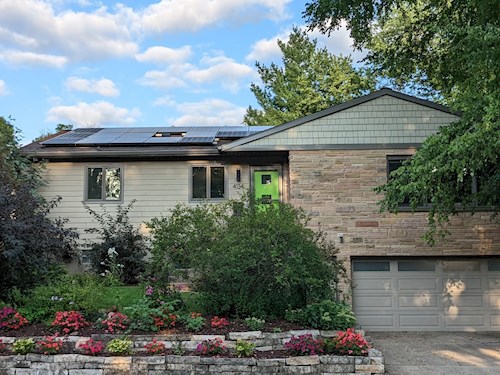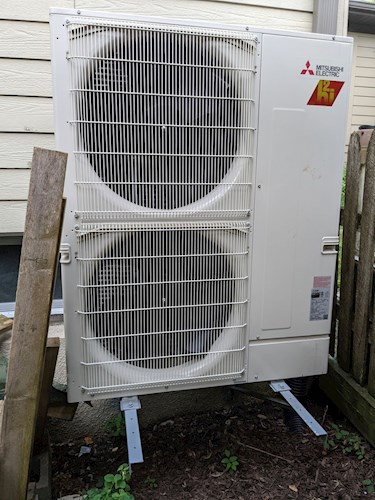

Dan Williams has always been interested in sustainability. His older home was heated by a fossil gas-fueled boiler and cooled with traditional central air conditioning. In order to reduce his future reliance on fossil fuels, he decided he wanted to transition to an air-source heat pump to heat and cool his house.
Although a heat pump might sound new, the reality is that this same technology is what cools a refrigerator. Air conditioners also use heat pump technology, though they only cool, whereas a heat pump runs in both directions–heating and cooling. To learn more about heat pump technology, check out the Heat Pump 101, 102 and 201 blogs by Focus on Energy.
Relative to heating and cooling a home, there are several heat pump options:
Because Dan has an older home, he started with an energy evaluation to determine where heat was being lost from his home, as heat pumps work most efficiently in weatherized houses. Once the areas of biggest heat loss were found he was able to do air sealing and add insulation so that the heat and cool produced in his house stayed in his house.
Dan pursued a cold climate heat pump and also a heat pump water heater, which replaced his fossil gas water heater. He worked with a contractor to choose the right type of heat pump and determine the correct model and size for his house.

(Outside element of an air source heat pump. Photo by Dan Williams.)
Dan’s cold climate air source heat pump was installed in March 2022. He also installed an energy recovery ventilator that takes heat from air leaving the house and uses it to heat the air coming into the house, allowing for increased fresh air while reducing wasted energy.
Dan’s fossil gas boiler is still working so he left it in place. He still has a gas stove as well. The heat pump that Dan chose works down to -13°F and has 100% heating capacity at any temperature above 5°F. If our area experiences an extended polar vortex, Dan’s boiler can provide supplementary heat. His heat pump also has an electric resistance coil backup heater. It’s less efficient than the heat pump, but in a well-insulated house it’s unlikely to be needed often. Dan’s plan is to keep the boiler for a few winters as backup for the new system. Since it will run infrequently, his boiler could operate for many years.
Proactive Planning
Dan’s approach to electrification is smart in several ways. He pursued energy efficiency first, which made the heat pump options more viable. And he pursued the heat pump before his boiler failed. Often people do not think about their heating and cooling equipment until it fails and then there is pressure to install something right away, rather than looking at the options. Planning ahead ensures that you are not locked into an inefficient heating system for decades.
Dual Fuel
Dan’s approach, a dual fuel arrangement, is one that is likely to become more common in Wisconsin. As the cost of heat pump systems go down (and incentives go up) more and more people are installing an air source heat pump to replace their central air conditioner system. In this scenario the heat pump does all the cooling and some of the heating, extending the life of the fossil gas heating system while reducing how often that fossil gas system runs–which cuts greenhouse gas emissions.

(The inside component of a ducted air source heat pump. Photo by Dan Williams.)
Why Transition to a Heat Pump?
The advantages to a heat pump, Dan says, are many. For one, it’s simply more comfortable. There are more options for controlling the speed and airflow of the heat than on his previous heating system, which leads to gentler, more consistent heat. He’s also very pleased with the humidity levels.
Also important are the energy savings. Natural gas prices continue to rise. The National Energy Assistance Directors Association estimates it will cost more than $1,200 to heat an average home this winter, an increase of more than 17% from last. To combat rising energy prices and transition to renewable energy, Dan has paired his heat pump system with solar panels that cover 85-90% of his electricity. That means his household energy costs are essentially fixed for decades, and he doesn’t have to worry about whether he’ll be able to afford ever-growing heating bills.
Finally, federal and state incentives make transitioning to a heat pump even more economically viable. Starting in January 2023, the Inflation Reduction Act includes rebates of up to $8,000 for a heat pump for space heating or cooling, up to $1,750 for a heat pump water heater, and up to $840 for an electric heat pump clothes dryer and/or an electric stove or oven. There are also rebates for improving insulation and air sealing or upgrading an electric panel to run new electric appliances. Focus on Energy has additional incentives available for Wisconsin residents.
Making the Switch
Switching over to a heat pump can feel like a big change, but Dan says there’s a simple solution: reach out to other people who have done it and ask about their experiences. As for Dan, he’s glad he made the switch and he hopes he can “share this experience retrofitting an older home with others to help them along this path.”
For more information about heat pumps and the Inflation Reduction Act, check out another Madisonian’s efforts to fully electrify her house, as well as “'A little bit for everybody': How the Inflation Reduction Act boosts clean energy” and Here’s how the US climate bill will reduce household energy bills.

Heather is passionate about protecting our climate and inspiring communities to take action for a sustainable future. As the Climate Action Intern, Heather is focused on outreach for the Climate Champions program and sharing climate action successes through blog posts, the Clean Energy Map, and stories of the county’s new Climate Champions. Heather has a background in education and library work, including teaching English in the Philippines and China, where she’s seen first-hand the challenges of a changing climate. Heather has a Master’s of Library and Information Studies from the University of Wisconsin - Madison and a Bachelor’s Degree in political science from the University of Wisconsin - Eau Claire. In her free time, Heather enjoys reading, playing handbells, painting, baking, and playing with her cat.
The Dane County Office of Energy & Climate Change maintains this blog as a way to offer:
To be sure that you don't miss new blog entries, subscribe to our email updates.